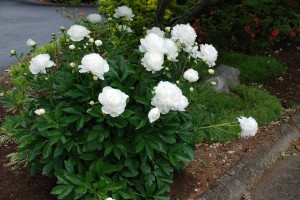Grandma’s peonies (Paeonia lactiflora) are back in vogue. There are single- or double- flowered varieties. The single petalled types appear to Southern U.S. heat better (USDA hardiness zones 3-8). May blooming peonies come in red, pink, purple, yellow, or white colors. Depending on variety, plants grow 3 to 4 feet high and wide. Their large showy flowers attract numerous pollinating insects.
Many old–timey varieties are as popular today as they were nearly a century ago. ‘Festiva Maxima’ (double white with red splash), ‘Kansas’ (double red), ‘Raspberry Sundae’ (double light pink), ‘Sarah Bernhardt’ (double pink), and ‘Seashell’ (single pink) are some heirloom favorites.
Peonies are commonly planted as foundation shrubs because of their bushy appearance. They are long-lived perennials which take a year, sometimes two, to become established (bloom well). Shoots die back in late October and can be cut away either fall or winter.
Grow peonies in full sun and compost-rich soil. Prepare the soil deeply in advance, adding lots of peat and/or compost. Afternoon shade is recommended in zones 7-b and 8.
Fall is the best time to plant peonies. Do not crowd peonies, spacing them 3 to 4 feet apart, according to the variety planted. Set the fleshy dormant roots, being careful not to bury the eyes more than 2 inches deep. Container grown plants may be set in spring or fall.
Lay a 2 to 3 inch organic mulch around peonies, using bark chips and not wood-based mulch. Irrigate peonies during extreme dry spells. Do not splash water on the foliage and flowers; overhead watering may initiate diseases such as leaf spots and botrytis. In late winter feed with granular 10-10-10 or equivalent fertilizer before peonies emerge from the soil.
Large double flowered types tend to fall to the ground after a hard rain unless supported by a special wire “peony cage”. Place one or more wire supports above each plant soon after spring growth starts.
Peonies seldom need dividing, which is performed in the fall. Ants are not a pest on peonies and actually aid in pollinating the flowers.
If you’re shopping for either old or new P. lactiflora cultivars, check on-line at: Klehm’s Song Sparrow Nursery.


 Posted in
Posted in 
